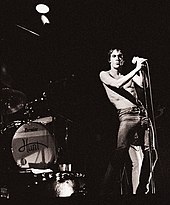Punk rock
Between 1974 and 1976, when the genre that became known as punk was developing, prominent acts included Television, Patti Smith, Richard Hell and the Voidoids, and the Ramones in New York City; the Saints in Brisbane; the Sex Pistols, the Clash, and the Damned in London, and the Buzzcocks in Manchester.[12] British punk rejected contemporary mainstream rock, the broader culture it represented, and their musical predecessors: "No Elvis, Beatles or the Rolling Stones in 1977", declared the Clash song "1977".Richard Hell's more androgynous, ragamuffin look—and reputed invention of the safety-pin aesthetic—was a major influence on Sex Pistols impresario Malcolm McLaren and, in turn, British punk style.[44] Over time, tattoos, piercings, and metal-studded and -spiked accessories became increasingly common elements of punk fashion among both musicians and fans, a "style of adornment calculated to disturb and outrage".[59] Nick Kent referred to Iggy Pop as the "Punk Messiah of the Teenage Wasteland" in his review of the Stooges July 1972 performance at King's Cross Cinema in London for a British magazine called Cream (no relation to the more famous US publication)."I told ya the New York Dolls were the real thing," he wrote, describing the album as "perhaps the best example of raw, thumb-your-nose-at-the-world, punk rock since the Rolling Stones' Exile on Main Street.[78][nb 3] In 1965, the Who released the mod anthem "My Generation", which according to John Reed, anticipated the kind of "cerebral mix of musical ferocity and rebellious posture" that would characterize much of the later British punk rock of the 1970s.[92] In Peru, founded in 1964, the group Los Saicos, used fast tempos, aggressive riffing, hoarses and screamed vocals along with souped-up tracks about prison escapes, funerals and destruction has led some publication to retrospectively credit them as pioneering punk rock.[98] The band's bassist/singer, Richard Hell, created a look with cropped, ragged hair, ripped T-shirts, and black leather jackets credited as the basis for punk rock visual style.[99] In Forest Hills, Queens, the Ramones drew on sources ranging from the Stooges to the Beatles and the Beach Boys to Herman's Hermits and 1960s girl groups, and condensed rock 'n' roll to its primal level: "'1–2–3–4!'In the words of John Walker, the record was "a turning point for the whole New York scene" if not quite for the punk rock sound itself – Hell's departure had left the band "significantly reduced in fringe aggression".[121] As described by critic Jon Savage, the band members "embodied an attitude into which McLaren fed a new set of references: late-sixties radical politics, sexual fetish material, pop history, [...] youth sociology".[128] A few even longer-active bands including Surrey neo-mods the Jam and pub rockers Eddie and the Hot Rods, the Stranglers, and Cock Sparrer also became associated with the punk rock scene.[153] The Sex Pistols' live TV skirmish with Bill Grundy on December 1, 1976, was the signal moment in British punk's transformation into a major media phenomenon, even as some stores refused to stock the records and radio airplay was hard to come by.[154] Press coverage of punk misbehavior grew intense: On January 4, 1977, The Evening News of London ran a front-page story on how the Sex Pistols "vomited and spat their way to an Amsterdam flight".[163] Alongside thirteen original songs that would define classic punk rock, the Clash's debut had included a cover of the recent Jamaican reggae hit "Police and Thieves".If the Sex Pistols' breakup the previous year had marked the end of the original UK punk scene and its promise of cultural transformation, for many the death of Vicious signified that it had been doomed from the start.[186] During 1976–1977, in the midst of the original UK punk movement, bands emerged such as Manchester's Joy Division, the Fall, and Magazine, Leeds' Gang of Four, and London's the Raincoats that became central post-punk figures.Post-punk brought together a new fraternity of musicians, journalists, managers, and entrepreneurs; the latter, notably Geoff Travis of Rough Trade and Tony Wilson of Factory, helped to develop the production and distribution infrastructure of the indie music scene that blossomed in the mid-1980s.[196] A distinctive style of punk, characterized by superfast, aggressive beats, screaming vocals, and often politically aware lyrics, began to emerge in 1978 among bands scattered around the United States and Canada.[202] A New York hardcore scene grew, including the relocated Bad Brains, New Jersey's Misfits and Adrenalin O.D., and local acts such as the Mob, Reagan Youth, and Agnostic Front.[203] By 1983, St. Paul's Hüsker Dü, Willful Neglect, Chicago's Naked Raygun, Indianapolis's Zero Boys, and D.C.'s the Faith were taking the hardcore sound in experimental and ultimately more melodic directions.[206] Straight edge bands like Minor Threat, Boston's SS Decontrol, and Reno, Nevada's 7 Seconds rejected the self-destructive lifestyles of their peers, and built a movement based on positivity and abstinence from cigarettes, alcohol, drugs, and casual sex.[213] As American alternative bands like Sonic Youth, which had grown out of the "no-wave" scene, and Boston's Pixies started to gain larger audiences, major labels sought to capitalize on the underground market."[216] Nirvana's success opened the door to mainstream popularity for a wide range of other "left-of-the-dial" acts, such as Pearl Jam and Red Hot Chili Peppers, and fueled the alternative rock boom of the early and mid-1990s.That June, Green Day's "Longview" reached number one on Billboard's Modern Rock Tracks chart and became a top forty airplay hit, arguably the first ever American punk song to do so; just one month later, the Offspring's "Come Out and Play" followed suit.[236] The following year, Enema of the State, the first fully major-label release by pop-punk band Blink-182, reached the top ten and sold four million copies in under twelve months.While they were viewed as Green Day "acolytes",[237] critics also found teen pop acts such as Britney Spears, the Backstreet Boys, and 'N Sync suitable points of comparison for Blink-182's sound and market niche.[261] The acts featured ranting vocals, discordant instrumental sounds, seemingly primitive production values, and lyrics filled with political and social content, often addressing issues such as class inequalities and military violence.According to music journalist Ben Myers, Bad Religion "layered their pissed off, politicized sound with the smoothest of harmonies"; Descendents "wrote almost surfy, Beach Boys-inspired songs about girls and food and being young(ish)".






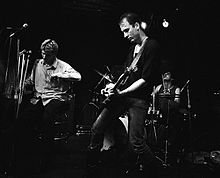



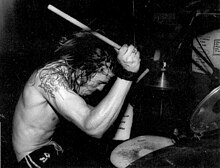


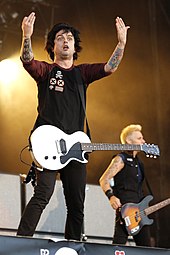


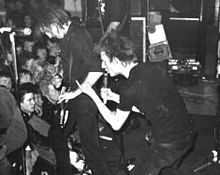

Punk rock (disambiguation)Garage rockproto-punkrock and rollrockabillyglam rockpub rocksurf musicAlternative rockpop-punknew waveindie rockindustrialno wavenoise rockNWOBHMspeed metalthrash metalpost-punkglam punkAnarcho-punkart punkhardcore punkhorror punkpost-hardcorequeercoreriot grrrlskate punkstreet punkcomplete list2 Toneanti-folkcowpunkdance-punkdeathrockfolk punkgarage punkgrungeGypsy punkpsychobillypunk bluespunk jazzska punkpunk rapAustraliaBasque CountryBrazilCaliforniaCanadaFranceGermanyNetherlandsPhiladelphiaScotlandYugoslaviaGreeceBrisbaneDIY ethiclist of bands, 0–Klist of bands, L–Zlist of festivalspunk fashionHistory of the punk subculturepunk subculturepunk zinetimelineAnarchismGlossaryHistoryOutlineFeministPrimitivistSocial ecologyTotal liberationIndividualistEgoistMarketPhilosophicalMutualistReligiousChristianJewishSocialCollectivistPareconCommunistMagonismWithout adjectivesCounter-economicsIllegalismInsurrectionaryPacifistPlatformismRelationshipSyndicalistSynthesisAnarchyAnarchist Black CrossAnarchist criminologyAnationalismAnti-authoritarianismAnti-capitalismAnti-militarismAffinity groupAutonomous social centerBlack blocClassless societyClass struggleConsensus decision-makingConscientious objectorCritique of workDecentralizationDeep ecologyDirect actionFree loveFreethoughtHorizontalidadIndividualismMutual aidParticipatory politicsPermanent autonomous zonePrefigurative politicsProletarian internationalismPropaganda of the deedRefusal of workRevolution
